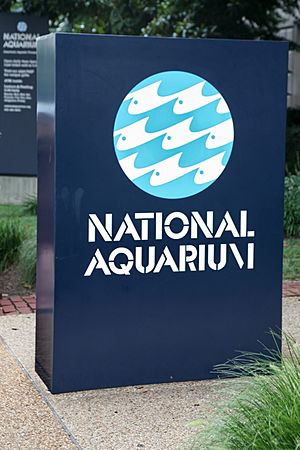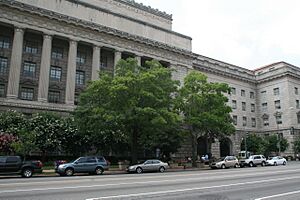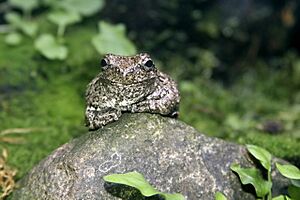National Aquarium (Washington, D.C.) facts for kids

Entry sign for the National Aquarium in Washington, DC, which was located on the lower level of the Department of Commerce Building
|
|
| Date opened | 1873 (152 years ago) |
|---|---|
| Date closed | September 30, 2013 |
| Location | Herbert C. Hoover Building Washington D.C., United States |
| Coordinates | 38°53′37″N 77°01′58″W / 38.8936°N 77.0328°W |
| No. of species | 250 |
| Memberships | AZA |
The National Aquarium, Washington, D.C., was a special place in Washington D.C. where you could see amazing aquatic animals. It was located inside the Herbert C. Hoover Building. This aquarium was the very first free public aquarium in the United States.
It was smaller than the National Aquarium in Baltimore, Maryland. Even though they shared a similar name, they were separate until 2003. The Washington D.C. aquarium closed its doors on September 30, 2013. It had been open for 140 years, making it the longest-running aquarium in the U.S. at that time.
Contents
A Look Back: The Aquarium's Journey
The National Aquarium first started in 1873 in Woods Hole, Massachusetts. It was created by the United States Fish Commission, led by Spencer Baird. It showed off 180 different kinds of fish, reptiles, and other water creatures.
In 1878, the aquarium moved to Washington, D.C. It was first located near the Washington Monument. There, it had special ponds called "Babcock Lakes." Later, it moved into a building called Central Station. This move helped it focus on its main job: raising fish for distribution across the country.
Over the years, the aquarium's management changed hands several times. It became part of different government departments. In 1932, it found its home on the lower level of the new Commerce Department building. It stayed there for many decades.
In 2003, the Washington D.C. aquarium teamed up with the National Aquarium in Baltimore. This partnership aimed to make both aquariums better. They wanted to improve their animal collections and educational programs.
Two Aquariums, One Name: Washington D.C. and Baltimore
The National Aquarium in Baltimore, Maryland, is a different aquarium. It opened in 1981. Both aquariums used the name "National Aquarium." The one in Washington D.C. was older, but the one in Baltimore is much larger.
Neither aquarium was run or funded by the federal government. They were also not part of the famous Smithsonian Institution.
On September 4, 2003, the two aquariums officially formed an alliance. The Baltimore aquarium agreed to help operate the D.C. aquarium. This partnership allowed them to work together more closely.
Amazing Animals: The Aquarium's Collection
The National Aquarium in Washington, D.C., was home to over 1,500 animals. These animals represented 250 different species. Visitors could see many interesting creatures. Some popular animals included longsnout seahorses, leopard sharks, and giant Pacific octopuses. There were also American alligators, loggerhead sea turtles, and even piranhas.
Ocean Wonders: National Marine Sanctuaries Gallery
This gallery showed animals and habitats from America's National Marine Sanctuaries. These are special ocean areas protected by the government. You could learn about places like the Florida Everglades and the Florida Keys National Marine Sanctuary.
Animals featured here included:
River Life: America's Freshwater Ecosystems Gallery
This gallery focused on important American rivers. It highlighted the Rio Grande, the Potomac River, and the Mississippi River. You could see animals that live in these freshwater environments.
Some animals in this gallery were:
Leaping and Crawling: Amphibians Gallery
This gallery was all about salamanders, newts, frogs, and toads. It showed how these amazing creatures adapt to their surroundings. You could learn about their unique biology.
Featured animals included:
- Eastern newt
- Barking tree frog
- Yellow-banded poison dart frog
- American toad
Jungle Journey: Amazon River Basin Gallery
The Amazon River and its surrounding area are full of diverse life. This gallery brought a piece of the Amazon to Washington D.C. It showcased some of the incredible animals found there.
Animals you might have seen included:
- Red-bellied piranha
- Silver arowana
- Blue poison dart frog
- Electric eel
The Aquarium Closes Its Doors
The National Aquarium in Washington, D.C., closed permanently on September 30, 2013. This happened because the Herbert C. Hoover Building was going to be renovated. At the time, it was the oldest continuously running aquarium in the United States.
About 1,700 fish and other animals from its collection moved to the National Aquarium in Baltimore. Officials thought about opening the aquarium in a new location in Washington, D.C. However, those plans were eventually put aside.



